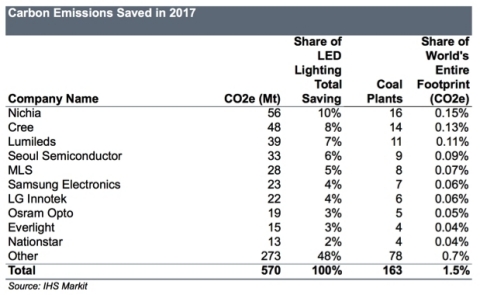The use of LEDs in buildings and outdoor spaces reduced the total carbon dioxide (CO2) emissions of lighting by an estimated 570 million tons in 2017, says a new report from IHS Markit.
LED lighting uses an average of 40 percent less power than fluorescents, and 80 percent less than incandescents, to produce the same amount of light.
“The efficiency of LEDs is essentially what makes them environmentally friendly,” said Jamie Fox, principal analyst, lighting and LEDs group, IHS Markit. “Therefore, LED conversion is unlike other measures, which require people to reduce consumption or make lifestyle changes.”
LED component and lighting companies were responsible for reducing the global carbon (CO2e) footprint by an estimated 1.5 percent in 2017, and that number is likely to continue to grow as more LEDs are installed around the world.
LEDs have other positive environmental benefits, too. For example, LEDs have a longer life span than traditional bulbs and fewer are produced, so the emissions and pollution associated with the production, shipping, sale and disposal of the products is lowered.
Secondly, unlike fluorescents, LEDs do not contain mercury. LEDs also decrease air pollution, since most electrical energy is still generated by burning fossil fuels. “While other activities affect climate change more than lighting does, it is still a very strong contribution from a single industry sector,” Fox said.
Among the top LED component suppliers, Nichia claims the credit for having saved the most carbon overall — accounting for 10 percent of all LED lighting reduction achieved in 2017. Cree followed Nichia with 8 percent, while Lumileds, Seoul Semiconductor, MLS, Samsung and LG Innotek each have a share in the range of 4 percent to 7 percent.
Savings achieved by each company relate to the energy saved by the use of that company’s components while installed in lighting applications. It does not include a whole lifecycle analysis, which would likely lead to a small additional positive benefit, due to the longer life of LEDs.
editor@greentechlead.com

